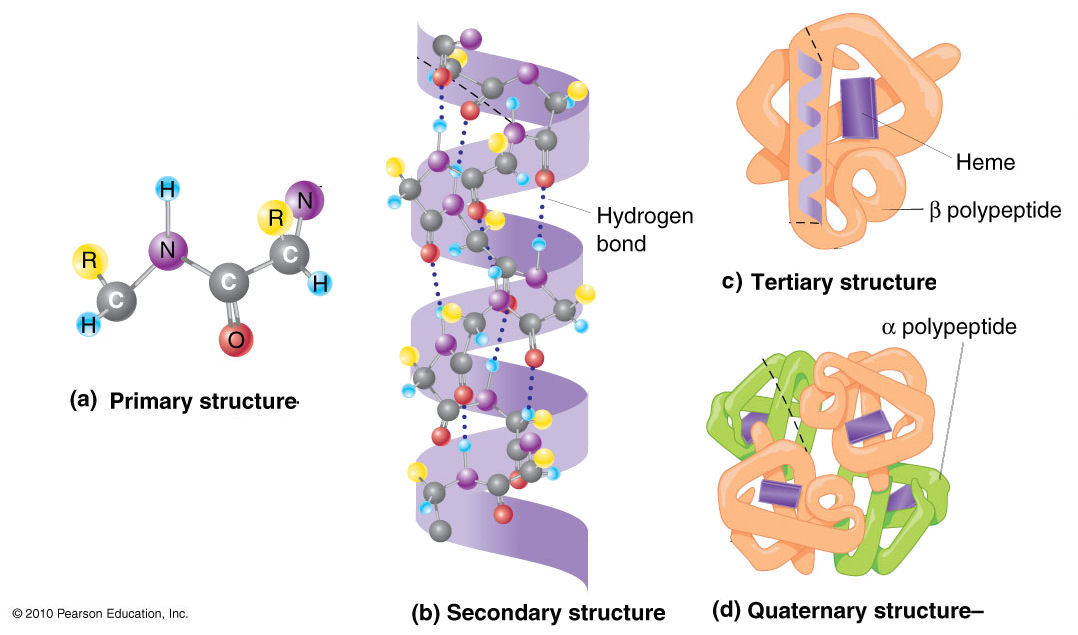Describe the Differences in the Four Protein Structures
The four levels of protein structure are primary secondary tertiary and quaternary structure which are distinguished from one another by the degree of complexity in the polypeptide chain. To determine how the protein gets its final shape or conformation we need to understand these four levels of protein structure.

Major Differences Com Biochemistry Biochemistry Notes Protein Biology
The complete structure of a protein can be described at four different levels of complexity.
. Refers to the coiling or folding of a polypeptide chain that gives the protein its 3-D shape. Explain what happens if even one amino acid is substituted for another in a polypeptide chain. 3 - What are the structural differences between RNA.
The following points highlight the four main structures of Protein Organisation. Aquaporins are proteins embedded in the plasma membrane that allow water molecules to move between the extracellular matrix and the intracellular space. Secondary structure refers to stable structural patterns of the peptide chains.
Basically there are four types of protein structuresa Primary structure. Hydrogen bonds between polar amino acids ionic bonds covalent bonds between sulphur containing amino acids hydrophobic interactions between non-polar amino acids. The basic sequence of amino acids of a given polypeptide linked.
3 - What are the four types of RNA and how do they. Provide a specific example. Secondary Structure - refers to the coiling or folding of a polypeptide chain that gives the protein its 3-D shape.
3d Describe the four levels of protein structure As a polymer a protein is a from BSC 1005 at Miami Dade College Miami. As a multitude of protein structures are rapidly being determined by Xray crystallography and by nuclear magnetic resonance NMR it is becoming clear that the number of unique folds is far. 3 - Describe the differences in the four protein.
To understand how a protein gets its final shape or conformation we need to understand the four levels of protein structure. Give the name of the fourth protein structure and what makes it. Made of 2 or more polypeptides.
Describes the unique order in which amino acids are linked together to form a protein. It is the description of basic structure of a protein. As we mentioned in the last article on proteins and amino acids the shape of a protein is very important to its function.
Terms in this set 4 Primary Structure. And within the completed protein structure each individual polypeptide is termed a subunit. A proteins primary structure is.
Silk a fibrous protein however has a β-pleated sheet structure that is the result of hydrogen bonding between different chains. There are two types of secondary structures observed in proteins. B The secondary structure is the 3-D arrangement of the right-handed alpha helix shown here or alternative structures such as a beta-pleated sheet.
The specific sequence of amino acids making up a polypeptide chain. And so lets say I have one folded up polypeptide two folded up polypeptides and a third and a fourth. Tertiary Structure - refers to the comprehensive 3-D structure of the polypeptide chain of a protein.
The secondary structure is determined by the dihedral angles of the peptide bonds the tertiary structure by the folding of proteins chains in space. The four levels of protein are1 Primary Structure2 Secondary Structure3 Tertiary Structure4 Quaternary StructureThe primary structure is just the amino acids bonded to eachother in a linear. The sequence of amino acids in a protein is called its primary structure.
The Four Levels of Protein Structure. The four levels of protein structure primary secondary tertiary and quaternary are illustrated in Figure 9. Four levels of Protein Structure.
The quaternary structure is described by the interactions between these four polypeptides. Proteins are constructed from a set of 20 amino acids. C The tertiary structure is the 3-D folding of the alpha helix show as a.
3 - Aquaporins are proteins embedded in the plasma. Primary secondary tertiary and quaternary. Primary secondary tertiary and.
Generally amino acids have the following structural properties. Proteins structures are made by condensation of amino acids forming peptide bonds. Since this protein has four subunits it is called a tetramer.
A The primary structure is the succession of amino acid residues usually abbreviated by the 1- or 3-letter codes. Primary Structure of Proteins. Formed from interactions between R-groups.
Tertiary structure describes all aspects of the three-dimensional folding of a polypeptide. The amino acid sequence in the peptide chains of the protein and the bonding between them -like peptide hydrogen sulphide describe the primary structure. It is convenient to describe protein structure in terms of 4 different aspects of covalent structure and folding patterns.
The different levels of protein structure are known as primary secondary tertiary and quaternary structure. Primary structure describes the sequence of amino acids in the polypeptide chain which is unique and specific to a particular protein. Primary secondary tertiary and quaternary structure.
Describe the differences in the four protein structures. One type is the alpha α helix structure. 3 - Explain what happens if even one amino acid is.
Early structural biochemists conceptually divided protein structures into four levels to make it easier to get a handle on the complexity of the overall structures. The regular local patterns of coils or folds of a polypeptide chain.

Four Levels Of Protein Structure

Comments
Post a Comment